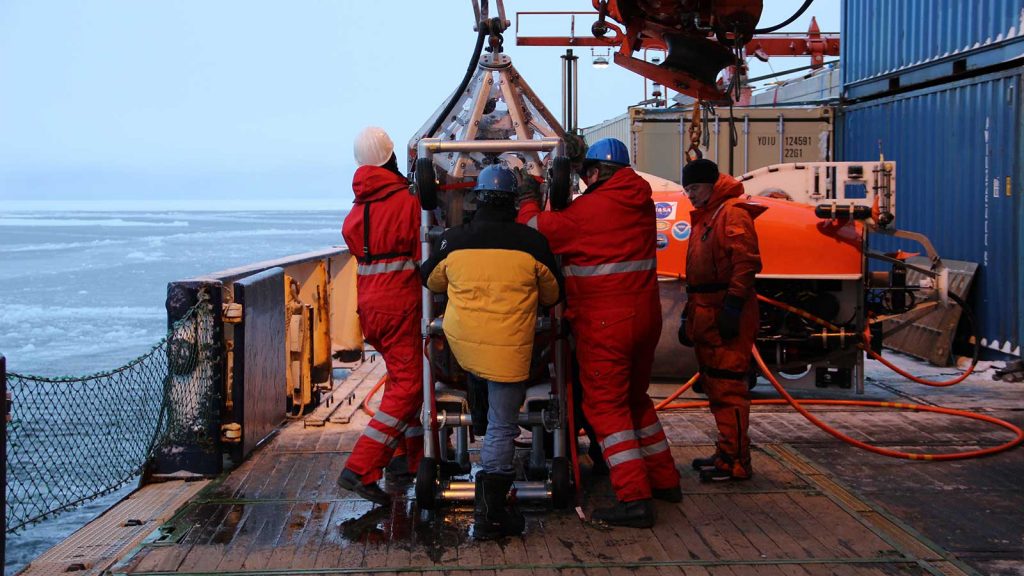
The Polarstern crew prepares the OFOS camera platform for deployment. (Photo by Chris German, ©Woods Hole Oceanographic Institution)
We got our first look at the Gakkel Ridge seafloor late last night. And immediately decided to run away. We also got a first sniff of the hydrothermal plume we will be chasing, as well—albeit about 40 kilometers (25 miles) away from where we were extracting our mooring yesterday. But a sniff is a sniff and once you have picked up the scent, it is hard (for me, at least) to drag yourself away.
But one thing at a time. The reason we left the mooring site in such a hurry last night was that when we lowered a camera system to the seafloor to look for a place for our biologists to collect some sediment from, they realized there was nothing there for them to sample. Instead, the seafloor was covered with fresh volcanic rocks. (My kind of seafloor.)
That meant we could leave the work site early. It also meant that we could accelerate our NUI program today. First, we chose where to deploy our navigation beacons (called transponders) on the seafloor. When we launch NUI tomorrow, it will find its way around on the seafloor based on acoustic signals (sound waves) traveling through the ocean. So today, our main job, apart from getting NUI ready, was to work out where to place our two navigation beacons that will sit on the seafloor and each shout “ping” to NUI at a different note, so it can tell which beacon is where and how far away they are from the vehicle. It’s kind of like the world’s deepest, most ice-covered game of Marco Polo.
But before that we had to actually get to the site, so I didn’t rush out of my bunk first thing this morning and, once I was up, I did my daily ice-watch. Then, before lunch, I stopped off in the ship’s library (a very plush lounge area, one deck up from most of the scientists), where I spent a while talking with Jill about a paper she is working on from our previous work exploring the world’s deepest vent sites on the Mid-Cayman Rise, which doesn’t have any ice but is one of the closest matches geologically to where we are now.
Sitting the other side of the room was Kevin, who was getting ready to call in to the next “virtual” meeting of our NASA Europa Lander Science Definition Team (being at sea in the Arctic, I am excused, but Kevin is the co-Chair for the project, so he doesn’t get let off so lightly and had to bring his own satellite telephone). Anyway, because scientists are a curious bunch (note that there are many different ways that you can make use of “curious” in this sentence), our conversations about water-rock interactions at the deep seafloor soon migrated into discussions about what might be the best way to get a spacecraft to land upright on Europa.
All this happened before we even launched NUI!
This afternoon, we took a fresh trip to the seafloor with the OFOS camera system to check out a second hill that is as shallow as the one we will be diving on with NUI. We saw more of the same life all over the shallowest part, but not nearly so much just a few hundred meters deeper. And, WOW, what steep cliffs. I’m looking forward to driving up some of those with NUI and checking out the geology when the time comes. Finally, around 8:00 p.m, it was time to go set our beacons. The trouble is, a massive (like a mile or two across) ice flow had arrived right on the site while we were away.
“How important is it that we put the beacons where you want?” the Captain asked me.
“Pretty important, I’m afraid,” I replied.
“Not a problem,” he said. “Just wait and we will turn on our third engine and push the ice out of your way.”
Sure enough, only a little behind schedule, we arrived within less than 30 meters (100 feet) o fwhere we wanted to be. That’s precision engineering.
Finally, at 9:30 p.m., the beacon slid over the side of the ship. As I was writing down the time, GPS position, and water depth under the ship, the call came up from the deck on our radios, “Es ist Geschluppt!” The second and last beacon was on its way.
So all is now set. The beacons are in the right place on the seafloor and pinging their pre-arranged one-note tunes. The NUI engineering team is running through the final vehicle checks tonight and then tomorrow, we are set for a 6:30 a.m. start and 10:00 a.m. launch for NUI Dive #13.
Wish us luck.

